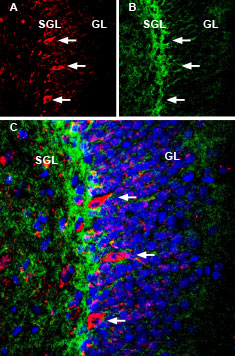Overview
- Peptide (C)SKSEEETSPLVTH, corresponding to amino acid residues 500-512 of mouse SLC1A4 (Accession O35874). Intracellular, C-terminus.
- Rat and mouse brain membranes and human Jurkat T-cells, and Colo 205 colon adenocarcinoma cell lysates (1:200-1:1000).
 Western blot analysis of mouse (lanes 1 and 3) and rat (lanes 2 and 4) brain membranes:1,2. Anti-ASCT1 (SLC1A4) Antibody (#ANT-081), (1:200).
Western blot analysis of mouse (lanes 1 and 3) and rat (lanes 2 and 4) brain membranes:1,2. Anti-ASCT1 (SLC1A4) Antibody (#ANT-081), (1:200).
3,4. Anti-ASCT1 (SLC1A4) Antibody, preincubated with ASCT1/SLC1A4 Blocking Peptide (#BLP-NT081). Western blot analysis of human Jurkat T-cell leukemia cell line lysate (lanes 1 and 3) and human Colo 205 colon adenocarcinoma cell line lysate (lanes 2 and 4):1,2. Anti-ASCT1 (SLC1A4) Antibody (#ANT-081), (1:200).
Western blot analysis of human Jurkat T-cell leukemia cell line lysate (lanes 1 and 3) and human Colo 205 colon adenocarcinoma cell line lysate (lanes 2 and 4):1,2. Anti-ASCT1 (SLC1A4) Antibody (#ANT-081), (1:200).
3,4. Anti-ASCT1 (SLC1A4) Antibody, preincubated with ASCT1/SLC1A4 Blocking Peptide (#BLP-NT081).
- Rat brain sections (1:300).
Glutamate transporters play important roles in the termination of excitatory neurotransmission and in providing cells throughout the body with glutamate for metabolic purposes.
SLC1A4 belongs to the SLC1 protein family which contains a range of human and prokaryotic glutamate and aspartate transporters such as the human glutamate transporters (otherwise known as excitatory amino acid transporters or EAATs).
SLC1A4 is detected in the brain, skeletal muscle, and pancreas. It is largely selective for alanine, serine, and cysteine but can also transport threonine, asparagine, and to a lesser extent, proline. In the brain, SLC1A4 is preferentially expressed in glial cells and has been suggested to be responsible for the release of L-serine from intracellular stores, in exchange for other extracellular substrates. SLC1A4 exhibits pH-dependent substrate selectivity. Acidic amino acids become substrates at pH 5.5, which may be physiologically important in the acidic environment of the digestive tract where SLC1A4 is involved in nutrient uptake.
Despite the high degree of sequence identity, ASCTs function quite differently from the EAATs. The EAATs transport the acidic amino acids glutamate and aspartate against a concentration gradient generating a net movement of substrate and charge across the membrane. In contrast, SLC1A4 exchanges small, neutral amino acids in an electroneutral fashion without generating net movement of substrate1.
Recent studies have shown that mutations in the SCL1A4 gene, which are common in Ashkenazi Jews, are associated with global developmental delay, microcephaly and hypomyelination2.
Application key:
Species reactivity key:
 Multiplex staining of GluN1 and ASCT1 in mouse hippocampus.Immunohistochemical staining of immersion-fixed, free floating rat brain frozen sections using Guinea pig Anti-NMDAR1 (GluN1) (extracellular) Antibody (#AGC-001-GP), (1:600) and rabbit Anti-ASCT1 (SLC1A4) Antibody (#ANT-081), (1:300). A. GluN1 (red) appears in profiles of hippocampal dentate gyrus interneurons (arrows). B. ASCT1 (green) appears in the extracelullar matrix of the subgranular layer (SGL). C. Merge of the two images demonstrates adjacent localization in several neurons (arrows). Cell nuclei are stained with DAPI (blue).GL = granule layer.
Multiplex staining of GluN1 and ASCT1 in mouse hippocampus.Immunohistochemical staining of immersion-fixed, free floating rat brain frozen sections using Guinea pig Anti-NMDAR1 (GluN1) (extracellular) Antibody (#AGC-001-GP), (1:600) and rabbit Anti-ASCT1 (SLC1A4) Antibody (#ANT-081), (1:300). A. GluN1 (red) appears in profiles of hippocampal dentate gyrus interneurons (arrows). B. ASCT1 (green) appears in the extracelullar matrix of the subgranular layer (SGL). C. Merge of the two images demonstrates adjacent localization in several neurons (arrows). Cell nuclei are stained with DAPI (blue).GL = granule layer.
